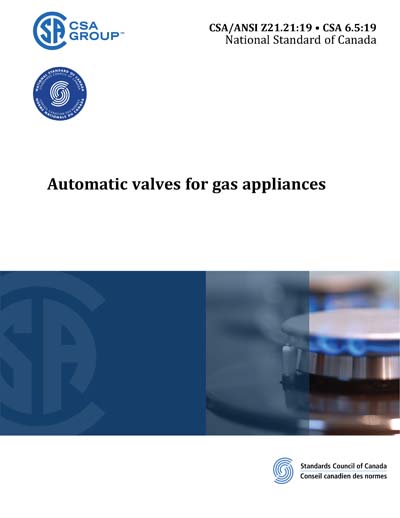Historical
CSA/ANSI Z21.21-19/CSA 6.5-2019
Automatic valves for gas appliances
Preface This is the sixth edition of CSA/ANSI Z21.21 • CSA 6.5, Automatic valves for gas appliances. It supersedes the previous editions published in 2015, 2012, 2005, 2000, and 1995. This Standard has been developed in compliance with Standards Council of Canada requirements for National Standards of Canada. It has been published as a National Standard of Canada by CSA Group. This Standard has been approved by the American National Standards Institute (ANSI) as an American National Standard. Scope 1.1 This Standard applies to newly produced automatic valves (see Clause 3, Definitions) constructed entirely of new, unused parts and materials. These valves may be individual automatic valves or valves utilized as parts of automatic gas ignition systems. This Standard also applies to commercial/industrial safety shutoff valves (see Clause 3), herein after referred to as C/I valves. This Standard does not apply to self-contained water heater, cooking appliance, or room heater thermostats, or self-contained automatic gas shutoff valves for hot water supply systems. Components performing functions other than those of an automatic valve are to comply with applicable American National Standards or Canadian Standards. Compliance of an automatic valve with this Standard does not imply that the automatic valve is acceptable for use on gas appliances without supplemental tests with the automatic valve applied to the particular appliance design. A control that incorporates two or more automatic valves and no other function, (as defined by combination control, see Clause 3), may be tested to this Standard or to the Standard for Combination Gas Controls for Gas Appliances, ANSI Z21.78 • CSA 6.20, at the discretion of the manufacturer. 1.2 The valve operator of an automatic valve may be actuated either directly or indirectly. In addition, it may be actuated by electrical means, by mechanical means, by means of a change of the absolute pressure of gas or air upon a diaphragm, or by other means. 1.3 This Standard applies to automatic valves having maximum operating gas pressure ratings from 1/2 psi (3.5 kPa) up to and including 60 psi (413.7 kPa). This Standard also applies to C/I valves having maximum operating gas pressure ratings of 1/2 psi (3.5 kPa) or greater (see Clauses 6 and 7). 1.4 This Standard applies to automatic valves that are to be mounted in the manufacturer’s specified upright position or in one or more of the optional mounting positions selected by the manufacturer. (See Clause 5.1.1.) 1.5 This Standard applies to automatic valves that are capable of operation at ambient temperatures of 32 °F to 125 °F (0 °C to 51.5 °C), unless a higher temperature, lower temperature, or both, are specified by the manufacturer. (See Clause 5.1.2.) 1.6 If a value for measurement as given in this Standard is followed by an equivalent value in other units, the first stated value is to be regarded as the specification. 1.7 All references to psi throughout this Standard are to be considered gauge pressures unless otherwise specified. 1.8 Additional provisions concerning electrical coverage applicable to units defined for use in the United States are outlined in Clause 9, Items unique to the United States. 1.9 Additional provisions concerning electrical coverage, instructions, and markings applicable to units destined for use in Canada are outlined in Clause 10, Items unique to Canada. 1.10 Clause 2, Reference publications, contains a list of standards specifically referenced in this Standard and sources from which they may be obtained. 1.11 In this Standard, "shall" is used to express a requirement, i.e., a provision that the user is obliged to satisfy in order to comply with the standard; "should" is used to express a recommendation or that which is advised but not required; and "may" is used to express an option or that which is permissible within the limits of the Standard. Notes accompanying clauses do not include requirements or alternative requirements; the purpose of a note accompanying a clause is to separate from the text explanatory or informative material. Notes to tables and figures are considered part of the table or figure and may be written as requirements. Annexes are designated normative (mandatory) or informative (non-mandatory) to define their application.
Content Provider
CSA America, Inc. [csa]






